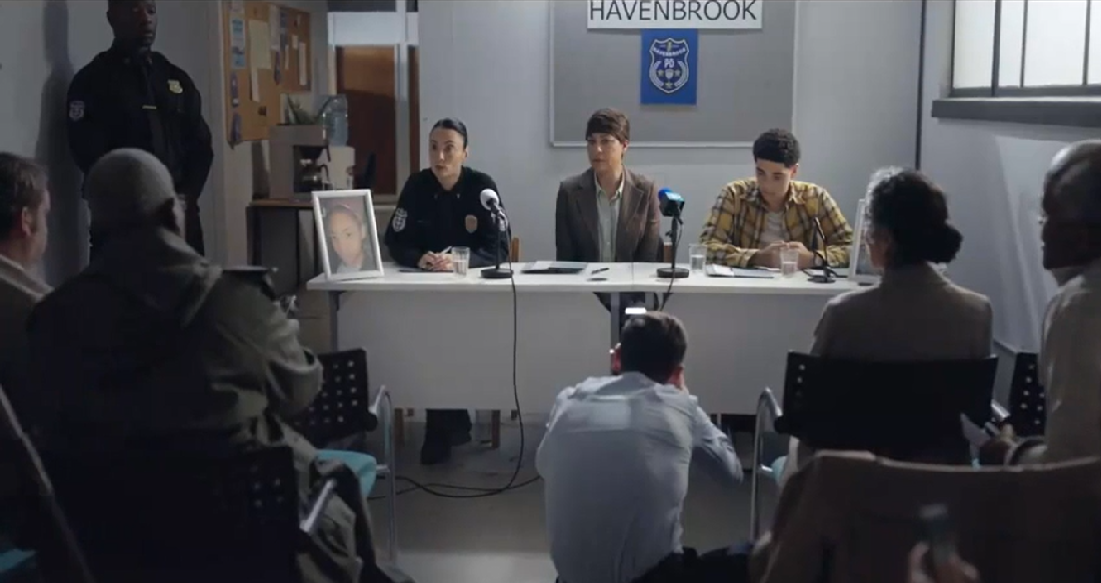Directed by Neil Rawles, Lifetime’s ‘The Girl in the Video’ unravels the tale of Krissy Meyers, a bright young woman with her whole life ahead of her. Sharing a cozy home with her mother, Mo Meyers, and her brother, Robbie Meyers, Krissy’s world seems secure—until an innocent online friendship with a boy named Toby takes a sinister turn. What begins as harmless, playful chats evolves into a nightmare when Krissy agrees to meet Toby, only to be abducted by a masked man at the rendezvous point. As her family frantically searches for answers, the police receive an anonymous tip leading to a dark web site where her abductor is broadcasting live streams of her captivity. The film explores the themes of trust, exploitation, and the lurking dangers of the digital world. It paints a stark warning about the hidden perils of our hyperconnected age.
Girl in the Video is a True Reflection of the Many Cases of Online Predators
‘The Girl in the Video’ is a film that speaks volumes about the challenges of our current day and age. With its nuanced handling of sensitive themes, it sheds light on the insidious dangers that can infiltrate a young person’s life. Inspired by true events, writers Matthew Broughton and Bruce Kennedy have crafted a realistic and gripping storyline that feels eerily plausible. However, the film is not confined to a single specific case. Instead, it serves as a broader reflection of similar harrowing incidents, echoing the ordeals of countless victims whose experiences align with the story of Krissy Meyers.
One strikingly similar case is that of Kayleigh Haywood, a 15-year-old from Measham, Leicestershire. In November 2015, Kayleigh began talking to a man named Luke Harlow online. At 27 years old, Luke was significantly older than Kayleigh, but in just two weeks, they exchanged more than 2,500 text messages. This led her to believe she had found a trusted friend. Unaware of his true age and intentions, she accepted his invitation to meet him at his house in Ibstock, Leicestershire. On November 13, 2015, she arrived at his home, and before she realized it, she was inebriated.

It has been reported that Harlow touched her inappropriately and then called his 29-year-old neighbor, Stephen Beadman. The latter sexually assaulted her before killing her. A missing report was filed, and on November 25, Kayleigh’s remains were found. An autopsy confirmed that she had died as a result of blunt force trauma to her head and face. Both of them were convicted on charges of assault and murder. Harlow was also convicted of grooming her and of falsely imprisoning her. In the film, even Krissy’s mother remarks that the length to which her abductor went to conceal his identity gave her daughter little chance. In Kayleigh’s case, too, the duplicity and manipulation were so high that it could only be described as the actions of a predator.
The Film Underscores the Increasing Threat of Digital Criminal Activity
Another case that bears some resemblance to the themes explored in the film is that of the 2012 murder of 33-year-old Chinese international student Jun Lin. He was studying at Concordia University and then connected with a man named Luka Magnotta through a dating app. The latter invited him to his house, where he brutally murdered him. A video titled ‘1 Lunatic, 1 Ice Pick’ was uploaded on bestgore.com on May 25, 2012. It showed Lin’s killing and in a few days, his dismembered remains were sent to the national headquarters of the Conservative Party of Canada. In June 2012, Magnotta was arrested and handed down a lifelong imprisonment.

Both the murders of Kayleigh Haywood and Jun Lin underscore the alarming dangers of predatory behavior and the calculated lengths to which individuals with malicious intent can go. In Kayleigh’s case, the illusion of friendship and trust built through weeks of online communication masked the dark intentions of her predator, Luke Harlow, who manipulated her vulnerability to lure her into a deadly situation. Similarly, Jun Lin’s tragic encounter with Luka Magnotta reveals how predators can exploit seemingly innocuous connections to commit premeditated and heinous acts. So, even though Mo and Krissy Meyers are not based on real victims and Toby is not an actual catfisher, their story matters because it emphasizes the critical need for awareness and vigilance in protecting oneself and others from the pervasive threats of today’s world.
Read More: Girl in the Basement True Story: Is Sarah Cody Real?


